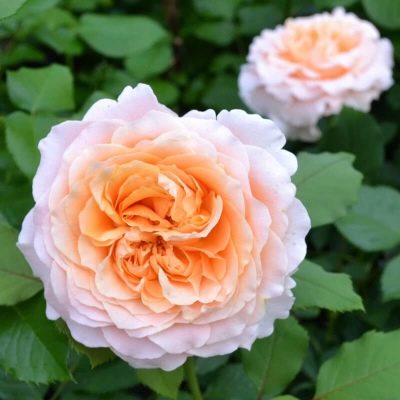
- Authors: Massad
- Name synonyms: Versigny
- Breeding year: 1992
- Group: scrub
- The main color of the flower: orange
- Flower shape: cupped, ruffled
- Flower size: medium
- Diameter, cm: 7-8
- Flower type by number of petals: thick double
- Scent: fruity, anise, apricot or peach, citrus and vanilla
When planning a flower bed in the courtyard of a private house or summer cottage, you want to plant something special and beautiful, pleasing to the eye, raising your spirits. For such a case, planting Versaini roses, of French selection, which grow beautifully separately, and in an ensemble with other plants, would be an excellent option.
Breeding history of the variety
The beautifully named Versaini rose from the work of a group of renowned French breeders who bred many pink varieties. A variety belonging to the shraba group was bred in 1992. The authorship belongs to the Massad family. The parent forms of the pink variety are Graham Thomas and Davidoff. Due to its stress resistance and high adaptive qualities, the French rose can be grown in different climatic zones of the Russian Federation.
Description of the variety
Rosa Versaini is an erect shrub that, under favorable conditions, stretches up to 120-130 cm in height. The plant is characterized by abundant branching, flexible and strong branches, moderate foliage, dark green leaves with a pronounced gloss, weak spine of the shoots and a developed rhizome. The volume of the bush is usually 70-80 cm.
A feature of the plant is the arrangement of branches that hang in arcs, which gives the pink shrub an unusually neat and attractive look. On each stem, 5-6 flowers are formed, beautifully collected in inflorescences.
Advantages and disadvantages
The French flower attracts not only with its external beauty and enchanting aroma, but also with a number of advantages: frost resistance (the plant can withstand temperature drops to -29 ... 23 degrees), good tolerance to rain and the scorching sun, excellent immunity, abundant and long flowering (about 3-4- x months) and intense aroma. No flaws were found in the flower.
Flowering features
Versaini belongs to the class of re-flowering. The budding period begins in June and ends in mid-September. The rose blooms profusely and in waves - some buds wither, while others are just blooming, so the bush is always beautiful and blooming. Neat goblet buds of pale orange or light salmon color are firmly attached to strong shoots.
As it unfolds, a medium-sized cupped rose takes on a tousled appearance. The diameter of the rose is about 7-8 cm. The densely doubled flower has a dense structure, consisting of many petals (more than 40-41). The blossoming rose has a magnificent color - soft salmon, with a brighter heart. Sometimes the roses are yellowish-pink in color with a copper core. The aroma of the flowers is bright, fruity, in which notes of apricot, peach, citrus, vanilla and anise are noticeable.
Use in landscape design
The royal rose will be appropriate in any landscape style. The compactness and neatness of the bushes allows you to plant a rose even in small flower beds. Versaini can become the basis of a flower garden, as well as decorate a mixborder. Often the variety is used to create a hedge. The salmon rose is perfectly combined with the emerald foliage of other plantations.In addition, the variety is adored by florists, massively using the flower in festive and themed compositions. Some growers grow cut flowers, as roses stay in a vase for a long time, preserving their freshness, beauty and aroma.
Landing
The rose is planted in April-May, when the temperature has stabilized. In the southern regions, autumn planting of rose bushes is allowed - 3-4 weeks before frost (October). For growing roses, choose a leveled area where it is sunny, warm and light. It is important that the landings are protected from drafts and gusty winds.
The soil should be light, fluffy, nutrient-rich, fertile and well-drained. The plant does not like acidic and swampy soils. It is not recommended to plant a crop in lowlands, where cold air and water accumulate. The rhizome of rose bushes goes deep into the soil, so the occurrence of groundwater should be at the level of 120-150 cm, no less.
Growing and care
Roses are grown using seedlings. For this, holes are prepared in advance with a depth of 60 cm, where drainage and a layer of organic fertilizers mixed with the ground are introduced. Before planting, seedlings are treated with a growth stimulant. At the end of the planting procedure, they are watered abundantly with warm water, and the soil is tamped. Light mulching with soil is performed around the seedling.
Crop care consists of basic activities: regular watering, top dressing, loosening the soil, weeding row spacings, disease prevention, sanitary pruning of branches, shelter for the winter.
Watering and feeding
Bushes are watered weekly - 15-20 liters of settled water for each plant. In case of excessive drought, watering is needed more abundant - twice a week. It is recommended to apply fertilizers according to the schedule - 2-3 times per season. In the spring they feed them with nitrogen-containing components, and during the summer they apply potash and phosphorus fertilizers.
Pruning
Three prunings per season are required. Frozen shoots are removed in spring, branches are shortened. Autumn is the time for sanitary and rejuvenating pruning when the dry ones are removed. Sick and damaged branches. During the flowering period, you need to pluck withered flowers.
Frost resistance and preparation for winter
Bushes growing in regions with cold winters need shelter. For this, a frame is built, on which burlap or agrofibre is pulled. You can cover the plant after the air temperature has dropped to -7 degrees.
Diseases and pests
Due to their high immunity, roses are practically not susceptible to powdery mildew, rust and black spot.































































